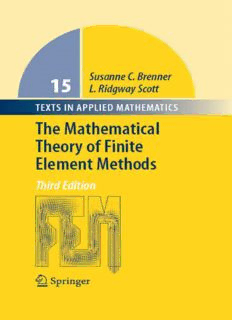
The mathematical theory of finite element methods PDF
Preview The mathematical theory of finite element methods
15 Texts in Applied Mathematics Editors J.E.Marsden L.Sirovich S.S.Antman Advisors G.Iooss P.Holmes D.Barkley M.Dellnitz P.Newton Texts in Applied Mathematics 1. Sirovich:IntroductiontoAppliedMathematics. 2. Wiggins:IntroductiontoAppliedNonlinearDynamicalSystemsandChaos. 3. Hale/Koc¸ak:DynamicsandBifurcations. 4. Chorin/Marsden:AMathematicalIntroductiontoFluidMechanics,3rded. 5. Hubbard/West:DifferentialEquations:ADynamicalSystemsApproach: OrdinaryDifferentialEquations. 6. Sontag:MathematicalControlTheory:DeterministicFiniteDimensional Systems,2nded. 7. Perko:DifferentialEquationsandDynamicalSystems,3rded. 8. Seaborn:HypergeometricFunctionsandTheirApplications. 9. Pipkin:ACourseonIntegralEquations. 10. Hoppensteadt/Peskin:ModelingandSimulationinMedicineandtheLife Sciences,2nded. 11. Braun:DifferentialEquationsandTheirApplications,4thed. 12. Stoer/Bulirsch:IntroductiontoNumericalAnalysis,3rded. 13. Renardy/Rogers:AnIntroductiontoPartialDifferentialEquations. 14. Banks:GrowthandDiffusionPhenomena:MathematicalFrameworksand Applications. 15. Brenner/Scott:TheMathematicalTheoryofFiniteElementMethods,3rded. 16. VandeVelde:ConcurrentScientificComputing. 17. Marsden/Ratiu:IntroductiontoMechanicsandSymmetry,2nded. 18. Hubbard/West:DifferentialEquations:ADynamicalSystemsApproach: Higher-DimensionalSystems. 19. Kaplan/Glass:UnderstandingNonlinearDynamics. 20. Holmes:IntroductiontoPerturbationMethods. 21. Curtain/Zwart:AnIntroductiontoInfinite-DimensionalLinearSystems Theory. 22. Thomas:NumericalPartialDifferentialEquations:FiniteDifference Methods. 23. Taylor:PartialDifferentialEquations:BasicTheory. 24. Merkin:IntroductiontotheTheoryofStabilityofMotion. 25. Naber:Topology,Geometry,andGaugeFields:Foundations. 26. Polderman/Willems:IntroductiontoMathematicalSystemsTheory: ABehavioralApproach. 27. Reddy:IntroductoryFunctionalAnalysiswithApplicationstoBoundary ValueProblemsandFiniteElements. 28. Gustafson/Wilcox:AnalyticalandComputationalMethodsofAdvanced EngineeringMathematics. 29. Tveito/Winther:IntroductiontoPartialDifferentialEquations: AComputationalApproach (continuedafterindex) Susanne C. Brenner L. Ridgway Scott The Mathematical Theory of Finite Element Methods Third Edition ABC SusanneC.Brenner L.RidgwayScott DepartmentofMathematicsandCenter UniversityofChicago forComputationandTechnology Chicago,IL60637 LouisianaStateUniversity USA BatonRouge,LA70803 [email protected] USA [email protected] SeriesEditors L.Sirovich J.E.Marsden DivisionofAppliedMathematics ControlandDynamicSystems,107-81 BrownUniversity CaliforniaInstituteofTechnology Providence,RI02912 Pasadena,CA91125 USA USA S.S.Antman DepartmentofMathematics and InstituteforPhysicalScience andTechnology UniversityofMaryland CollegePark,MD20742-4015 USA [email protected] ISBN978-0-387-75933-3 e-ISBN978-0-387-75934-0 DOI:10.1007/978-0-387-75934-0 LibraryofCongressControlNumber:2007939977 MathematicsSubjectClassification(2000):65N30,65–01,46N40,65M60,74S05 (cid:1)c 2008SpringerScience+BusinessMedia,LLC Allrightsreserved.Thisworkmaynotbetranslatedorcopiedinwholeorinpartwithoutthewritten permissionofthepublisher(SpringerScience+BusinessMedia,LLC,233SpringStreet,NewYork, NY10013,USA),exceptforbriefexcerptsinconnectionwithreviewsorscholarlyanalysis.Use in connection with any form of information storage and retrieval, electronic adaptation, computer software,orbysimilarordissimilarmethodologynowknownorhereafterdevelopedisforbidden. Theuseinthispublicationoftradenames,trademarks,servicemarks,andsimilarterms,evenifthey arenotidentifiedassuch,isnottobetakenasanexpressionofopinionastowhetherornottheyare subjecttoproprietaryrights. Printedonacid-freepaper 987654321 springer.com Series Preface Mathematics is playing an ever more important role in the physical and biological sciences, provoking a blurring of boundaries between scientific disciplines and a resurgence of interest in the modern as well as the clas- sical techniques of applied mathematics. This renewal of interest, both in research and teaching, has led to the establishment of the series Texts in Applied Mathematics (TAM). The development of new courses is a natural consequence of a high level of excitement on the research frontier as newer techniques, such as numerical and symbolic computer systems, dynamical systems, and chaos, mix with and reinforce the traditional methods of applied mathematics. Thus, the purpose of this textbook series is to meet the current and future needs of these advances and to encourage the teaching of new courses. TAMwillpublishtextbookssuitableforuseinadvancedundergraduate and beginning graduate courses, and will complement the Applied Mathe- maticalSciences(AMS)series,whichwillfocusonadvancedtextbooksand research-level monographs. Pasadena, California J.E. Marsden Providence, Rhode Island L. Sirovich College Park, Maryland S.S. Antman Preface to the Third Edition This edition contains four new sections on the following topics: the BDDC domain decomposition preconditioner (Section 7.8), a convergent adap- tive algorithm (Section 9.5), interior penalty methods (Section 10.5) and Poincar´e-Friedrichs inequalities for piecewise W1 functions (Section 10.6). p We have made improvements throughout the text, many of which were suggested by colleagues, to whom we are grateful. New exercises have been added and the list of references has also been expanded and updated. Some of the new material originated from our research and we would like to thank the National Science Foundation for support. The first au- thor would also like to thank the Alexander von Humboldt Foundation for supporting her visit to Germany in the Summer of 2007, during which the work on this edition was completed. The second author would also like to thanktheUniversit´ePierreetMarieCurieforsupportinghisvisitstoParis duringthepastseveralyears,duringwhichworkrelatedtothiseditionwas carried out. In the preface to the first edition, we outlined different ways the book couldbeusedincourses,butsincesomechapternumbershavechanged,we rephrase these suggestions here. Chapters 0 through 5 form the essential material for a course (these chapter numbers have not changed). Chapters 6 and 7 provide an introduction to efficient iterative solvers for the linear systems of finite element equations, but they do not contain material re- quired by later chapters. A course emphasizing algorithmic aspects would includethem.Similarly,Chapters8and9arenotrequiredinlaterchapters. Acoursecoveringchallenginganalysisquestionswouldcoverthese.Thefor- mer develops and applies max-norm error estimates to nonlinear problems, andthelatterintroducestheconceptofmeshadaptivity.Chapter10,how- ever, has an essential role in the subsequent chapters. But one could cover only the first and third sections of this chapter and then go on to Chapter 11 or 12 to study typical systems of differential equations found in appli- cations. Chapter 13 is essentially a continuation of Chapter 12. Chapters 10-13 form the core for a course emphasizing basic models in mechanics. Chapter 14 is an independent topic at a somewhat more advanced level that only depends on Chapters 0-5. It develops some functional analysis techniques and their application to finite element methods. Baton Rouge, LA Susanne C. Brenner Chicago, IL L. Ridgway Scott 20/07/2007 Preface to the Second Edition This edition contains two new chapters. The first one is on the additive Schwarz theory with applications to multilevel and domain decomposition preconditioners, and the second one is an introduction toa posteriori error estimators and adaptivity. We have also included a new section on an ex- ample of a one-dimensional adaptive mesh, a new section on the discrete Sobolevinequality andnewexercisesthroughout.Thelistofreferenceshas also been expanded and updated. We take this opportunity to extend thanks to everyone who provided comments and suggestions about this book over the years, and to the Na- tionalScienceFoundationforsupport.WealsowishtothankAchiDosanjh and the production staff at Springer-Verlag for their patience and care. Columbia, SC Susanne C. Brenner Chicago, IL L. Ridgway Scott 20/02/2002
Description: